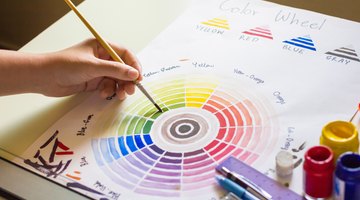A color wheel not only displays colors but also displays their relationships to each other. Color wheels can be constructed differently, beginning with the primary colors--blue, red and yellow, while more complex color wheels add colors which are a result of mixing previous colors. For example, the primary colors blue and yellow mix to produce green, which is a secondary color. Memorizing a color wheel can help you to better understand complementary and contrasting colors, and can also expand your color resources.
Copy existing color wheels of different levels. Begin with a primary color wheel, looking at the original and then copying it to a blank piece of paper. Each time you have successfully mastered one of the wheels, then graduate to the next level, such as the secondary color wheel, and then the tertiary wheel. Each level will add colors in between those that you have already memorized, providing the basis for the next level. Copy the color wheels as diagrams with the names of the colors labeled if you do not have access to color pencils or pens.
Create a mnemonic with the first letters of the color names of the respective wheels. A mnemonic is a memorization technique, which uses elements of the information that needs memorizing. A mnemonic using the first letters of the colors can either be a word constructed of those letters or a phrase utilizing words that begin with the same letters. For example, the primary color wheel with blue, red and yellow, can be converted to "Boys Running and Yelling."
Create a color clock. For each level of color wheel, divide the 12 hours of a clock face by the number of colors in the wheel. For example, for the primary colors, blue, red and yellow can each label four-hour blocks. Then, once each level is mastered, you can add colors to each of the appropriate sections. The higher the complexity, the more specific the time will become. For example, for the secondary colors, the clock face will be separated into six different sections, making each color a two-hour section.
Related Articles
Writer Bio
Chance E. Gartneer began writing professionally in 2008 working in conjunction with FEMA. He has the unofficial record for the most undergraduate hours at the University of Texas at Austin. When not working on his children's book masterpiece, he writes educational pieces focusing on early mathematics and ESL topics.











